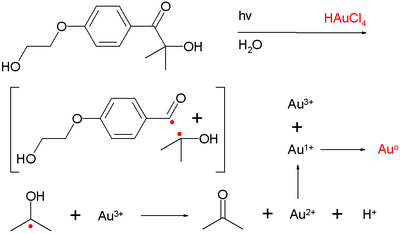- Norrish reaction
-
The Norrish reaction in organic chemistry describes the photochemical reactions taking place with ketones and aldehydes. This type of reaction is subdivided in Norrish type I reactions and Norrish type II reactions [1]. The reaction is named after Ronald George Wreyford Norrish.
Contents
Norrish I
The Norrish type I reaction is the photochemical cleavage or homolysis of aldehydes and ketones into two free radical intermediates. The carbonyl group accepts a photon and is excited to a photochemical singlet state. Through intersystem crossing the triplet state can be obtained. On cleavage of the α-carbon carbon bond from either state, two radical fragments are obtained.
Several secondary reaction modes are open to these fragments depending on the exact molecular structure.
- The fragments can simply recombine to the original carbonyl compound (path A).
- By extrusion of carbon monoxide in path B, two organic residues can recombine with formation of a new carbon carbon bond
- When the carbon fragment has an α-proton available it gets abstracted forming a ketene and a saturated hydrocarbon in path C
- When the alkyl fragment contains a β-proton it gets abstracted with formation of an aldehyde and an alkene.
The synthetic utility of this reaction type is limited. It often is a side reaction for instance in the Paternò–Büchi reaction. One organic synthesis based on this reaction is that of bicyclohexylidene [2].
Norrish II
A Norrish type II reaction is the photochemical intramolecular abstraction of a γ-hydrogen (which is a hydrogen atom three carbon positions removed from the carbonyl group) by the excited carbonyl compound to produce a 1,4-biradical as a primary photoproduct (IUPAC definition).
Secondary reaction are either intramolecular recombination of the two radicals to a cyclobutane compound (path A) or fragmentation to an enol and an alkene.
The reaction was first reported in 1937 by Ronald George Wreyford Norrish.
Scope
The Norrish reaction has been studied in relation to environmental chemistry with respect to the photolysis of the aldehyde heptanal, a prominent compound in Earth's atmosphere [3]. Photolysis of heptanal in conditions resembling atmospheric conditions results in the formation of 1-pentene and acetaldehyde in 62% chemical yield together with cyclic alcohols (cyclobutanols and cyclopentanols) both from a Norrish type II channel and around 10% yield of hexanal from a Norrish type I channel (the initially formed n-hexyl radical attacked by oxygen).
In one study [4] the photolysis of an Acyloin derivative in water in presence of hydrogen tetrachloroaurate (HAuCl4) generated nanogold particles with 10 nanometer diameter. The species believed to responsible for reducing Au3+ to Au0 [5] is the Norrish generated ketyl radical.
No less than three Norrish-type reactions feature in the classic 1982 total synthesis of dodecahedrane
References
- ^ Named Organic Reactions, 2nd Edition, Thomas Laue and Andreas Plagens, John Wiley & Sons: Chichester, England, New York, 2005. 320 pp. ISBN 0-470-01041-X
- ^ Bicyclohexylidene Nicholas J. Turro, Peter A. Leermakers, and George F. Vesley Organic Syntheses, Coll. Vol. 5, p.297 (1973); Vol. 47, p.34 (1967) Online article.
- ^ Photolysis of Heptanal Suzanne E. Paulson, De-Ling Liu, Grazyna E. Orzechowska, Luis M. Campos, and K. N. Houk J. Org. Chem.; 2006; 71(17) pp 6403 - 6408; (Article) doi:10.1021/jo060596u
- ^ Facile Photochemical Synthesis of Unprotected Aqueous Gold Nanoparticles Katherine L. McGilvray, Matthew R. Decan, Dashan Wang, and Juan C. Scaiano J. Am. Chem. Soc.; 2006; 128(50) pp 15980 - 15981; (Communication) doi:10.1021/ja066522h
- ^ Technically Au3+ is reduced to Au2+ which then forms Au+ and Au3+ by disproportionation followed by final reduction of Au1+ to Auo
External links
- IUPAC Gold Book Norrish type I definition
- IUPAC Gold Book Norrish type II definition
Categories:- Free radical reactions
- Photochemistry
- Name reactions
Wikimedia Foundation. 2010.




